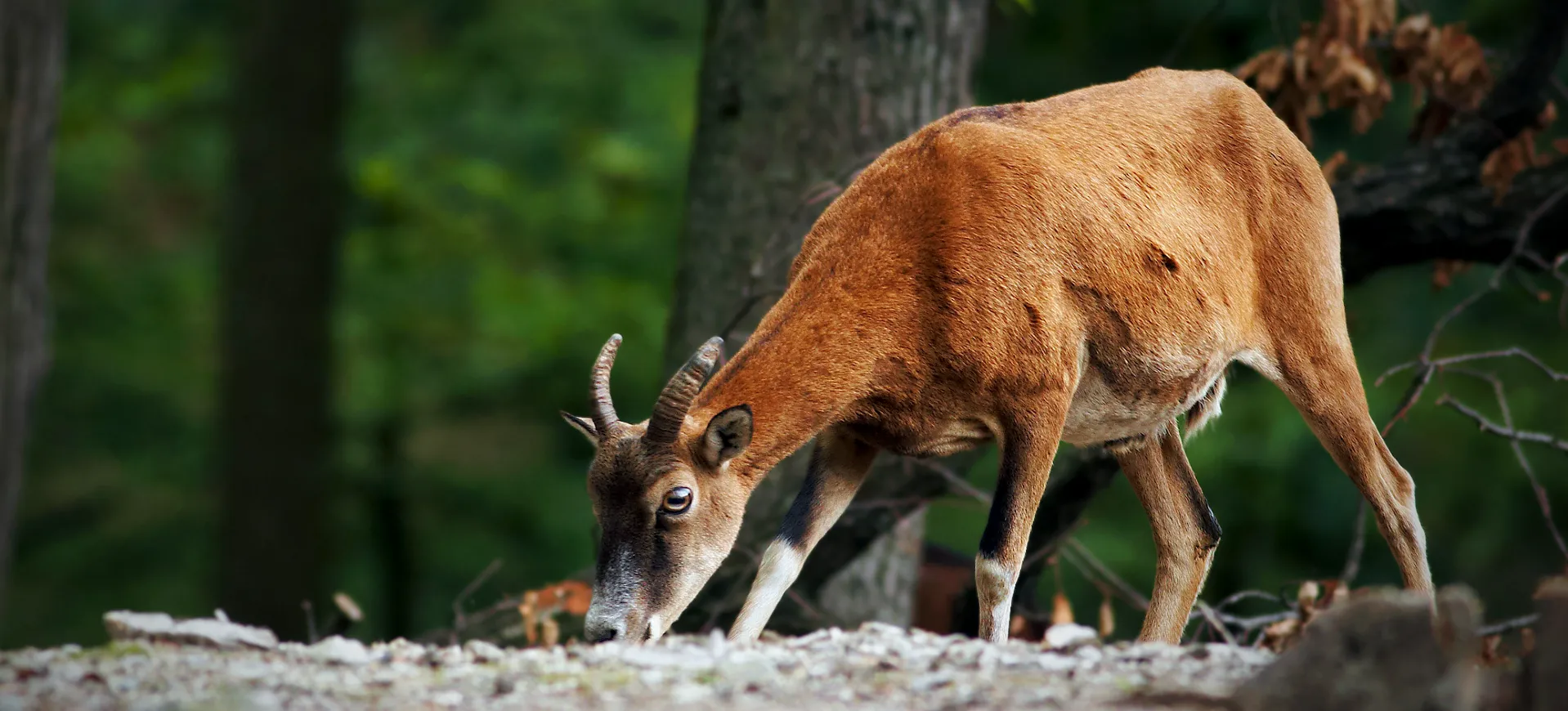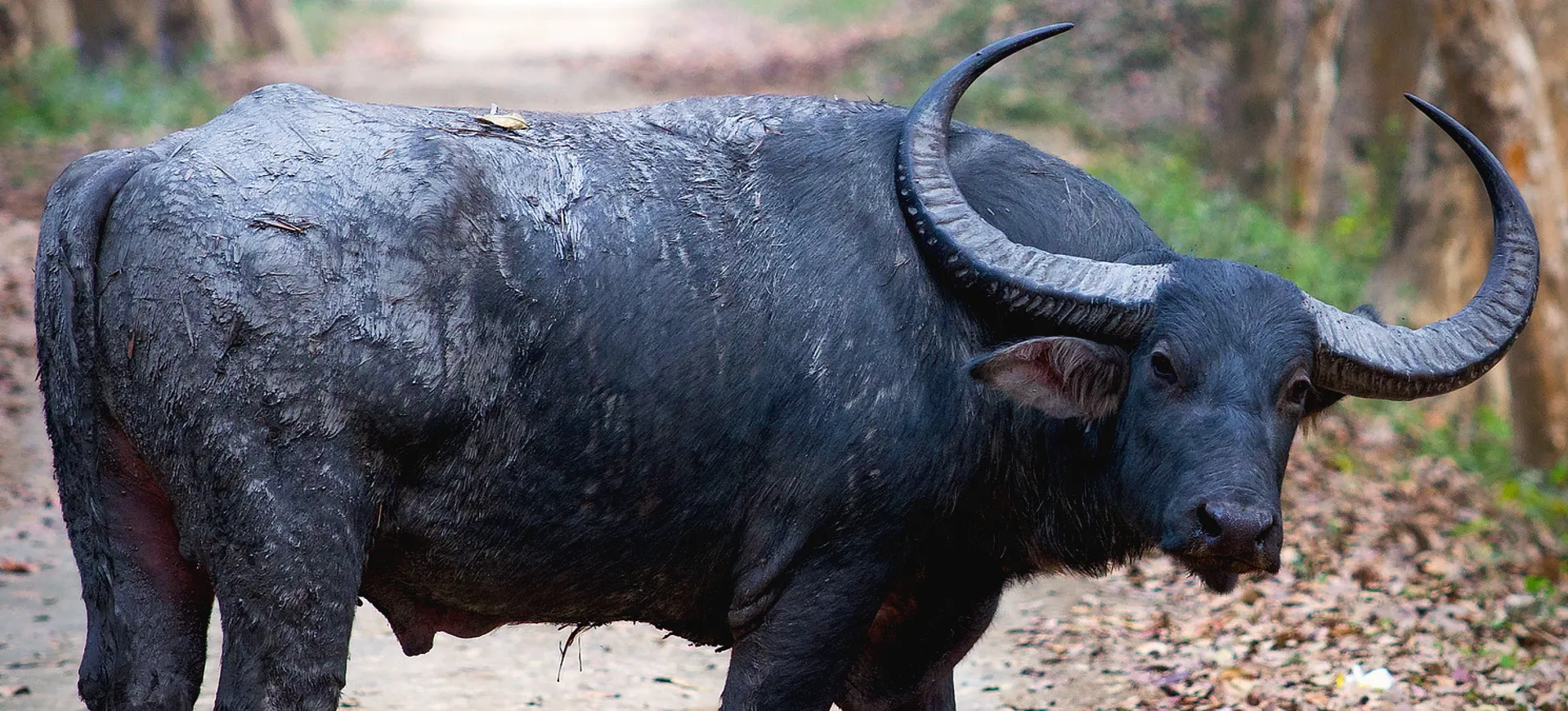Overview
The Lesser Kudu (Tragelaphus imberbis) is a forest antelope found in East Africa and is one of two species in the Kudu genus. Characterized by its slender body and long legs, the Lesser Kudu is noted for its striking spiral horns in males, which can grow up to 70 cm in length. Females, in contrast, do not have horns. Both genders display a sleek blue-grey coat with distinctive white stripes that help them blend in with their surroundings. The animal is mainly nocturnal, most active during early morning and late afternoon, and typically rests in the shelter of dense vegetation during the day.
Lesser Kudus is one of Africa’s most nimble and agile antelopes, capable of easily navigating rugged terrains. Despite their medium size, they can leap and clear obstacles as high as 2.5 m. They are also proficient climbers, using this skill to forage for fresh leaves and twigs in the tree canopy. A rather solitary animal, Lesser Kudus are known to lead elusive lives, which, combined with their natural camouflage, make them quite difficult to spot in the wild.
Notably, the Lesser Kudu has two subspecies: the northern Lesser Kudu (T. i. imberbis) and the southern Lesser Kudu (T. i. australis). While similar in appearance and behavior, the two subspecies have distinct geographical distributions, separated by the Tana River in Kenya.
Taxonomy
Kingdom
Phylum
Class
Order
Family
Genus
Species
Type
Physical Description:
The Lesser Kudu’s distinctive coat of grey-brown to blue-grey has 11-15 white stripes that run down the sides of its body from the backbone, offering excellent camouflage in its habitat. Its lower legs are tan, and the male’s neck, chest, and shoulders darken with age. Males possess impressive spiral horns, which twist 2.5 times and can reach lengths up to 70 cm. These horns are used for fighting other males, especially during the mating season. Females, however, are hornless.
Measuring from head to rump, the Lesser Kudu’s body length averages 110 to 175 cm. The tail length adds 25 to 40 cm. The body is noticeably compact and slender, contrasting with their long legs, enabling them to be great leapers. They have large, rounded ears and white facial markings, including two white cheek spots and a white stripe running from each eye to the muzzle.

Lifespan: Wild: ~15 Years || Captivity: ~20 Years

Weight: Male: 200 lbs (91 kg) || Female: 120 lbs (55 kg)

Length: Male: 175 cm (68 in) || Female: 150 cm (59 in)

Height: Male: 100 cm (39 in) || Female: 90 cm (35 in)

Top Speed: 60 mph (97 km/h)
Characteristic:
Native Habitat:
The Lesser Kudu inhabits dry, flat, and heavily forested regions. These regions are generally characterized by dense thickets and bushes interspersed with some open areas. They are often found in deciduous woodlands and acacia-commiphora bushlands, typically in low-rainfall areas. The Lesser Kudu prefers habitats with a good supply of fresh growth of woody plants.
The species shows a preference for areas that are close to water sources, although they are capable of surviving in regions with limited access to water. This is due to their ability to obtain sufficient moisture from their food. Lesser Kudus are rarely found in open grasslands as they rely heavily on dense vegetation for food and protection from predators.
Climate Zones:
Biomes:
Biogeographical Realms:
Continents:
Diet:
Diet & Feeding Habits:
Lesser Kudus are selective browsers, feeding primarily on the leaves, shoots, and twigs of bushes and low trees. Their diet can extend to over 100 different species of plants. They are not dependent on free water as they obtain most of the moisture they need from their food. This ability allows them to survive in relatively arid habitats.
Despite their dry environments, Lesser Kudus can be particular about their food choices, often picking out the leaves of one tree while completely ignoring another of the same species. The reason behind this selective feeding is not completely understood, but it is thought to help them avoid consuming high levels of toxins that some plants produce.
Mating Behavior:
Mating Description:
The mating system of the Lesser Kudu is polygynous, with males competing for access to females. During the mating season, males fight using their long spiral horns. These fights can become intense, but they rarely result in severe injuries. After mating, the male leaves the female, who raises the offspring alone.
Females reach sexual maturity at about 1-2 years, while males mature at around 1.5-2.5 years but only start breeding after acquiring a territory, typically around 4-5 years old. The estrous cycle lasts about 23 days, and females usually give a single birth per year. The peak birth periods correlate with the rains, which ensures abundant food for the lactating mother and the growing calf.
Reproduction Season:
Birth Type:
Pregnancy Duration:
Female Name:
Male Name:
Baby Name:
Social Structure Description:
Lesser Kudus are primarily solitary animals, particularly males, who usually live alone or in small bachelor groups. Females, on the other hand, form small family groups consisting of a mother and her offspring. An adult male may occasionally join these groups during the mating season.
Despite their solitary nature, Lesser Kudus are not territorial. Males may compete for female access during the breeding season but do not hold specific territories. Their social structure seems to be an adaptation to their arid environment, where food resources can be scarce and widely dispersed.
Groups:
Conservation Status:
Population Trend:
The Lesser Kudu population in the wild has been estimated to be approximately 118,000, with about 72,000 individuals in protected areas. Although these numbers seem substantial, the populations are scattered and fragmented due to habitat loss from human activities such as agriculture and livestock farming. This fragmentation makes the populations vulnerable to local extinctions.
Further, the Lesser Kudu faces threats from hunting and poaching for their meat and horns, particularly outside protected areas. The disease also poses a risk, especially when they contact domestic livestock. Despite these threats, Lesser Kudus have shown some resilience due to their adaptability to arid environments and their ability to survive without free water.
Population Threats:
Habitat loss and fragmentation due to agricultural expansion, settlement, and charcoal production are significant threats to the Lesser Kudu. Such activities reduce and isolate suitable habitats, making it harder for these antelopes to find food, water, and mates.
Hunting and poaching also pose a significant threat, particularly in regions outside of protected areas. Their meat is considered a delicacy, and their striking horns are sought after for trophy hunting. The Lesser Kudu is also susceptible to diseases, particularly those transmitted by domestic livestock, which can decimate local populations.
Conservation Efforts:
Efforts to conserve the Lesser Kudu have primarily focused on protecting its habitat and regulating hunting. This includes establishing and maintaining protected areas where agriculture and hunting are controlled. Conservation organizations also work with local communities to promote sustainable land-use practices and develop community-based conservation initiatives.
Educational campaigns are also crucial to raising awareness about the Lesser Kudu’s conservation status and the importance of conserving its habitat. Efforts are also being made to monitor the population and understand its ecology better, which will help develop more effective conservation strategies.
Additional Resources:
Fun Facts
- Lesser Kudus can survive without water for long periods, obtaining the moisture they need from the plants they eat.
- Males have long, spiraled horns that can grow up to 70 cm long.
- Despite their medium size, they can clear obstacles as high as 2.5 m when leaping.
- The Lesser Kudu leads a predominantly nocturnal lifestyle, being most active during the early morning and late afternoon.
- Females and young males live in groups, while adult males tend to be solitary.
- “kudu” comes from the Afrikaans word “komodo,” which means antelope.
- They have excellent jumping abilities and can jump up to 2.5 meters high to escape from predators.
- Lesser Kudus are very good climbers and are often seen feeding on leaves and twigs in trees.
- The gestation period for a Lesser Kudu is about eight months, after which a single calf is usually born.
- The Lesser Kudu’s main predators include lions, African wild dogs, leopards, and hyenas. However, their excellent camouflage and agile bodies allow them to escape most threats.
















































































